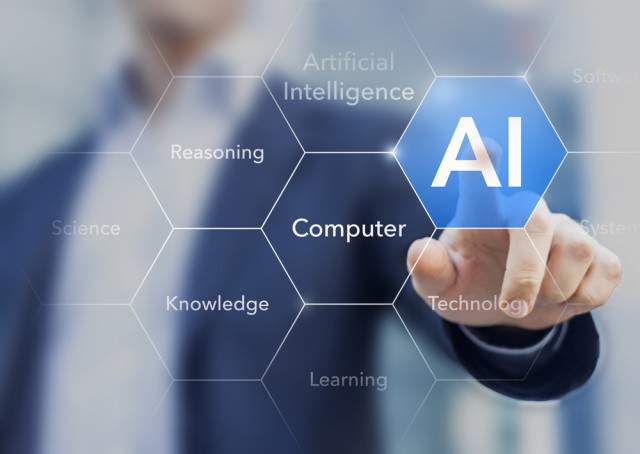AI and Machine Learning: Not just for data scientists anymore

While industry thought leaders are predicting a surge in the use of artificial intelligence (AI) and machine learning this year, much of that usage is still siloed in the hands of large technology enterprises such as Apple, Google, and Facebook. In fact, your smartphone has a lot more AI in it than your local call center operator terminal. In a recent Forrester survey among technology and business professionals, 58 percent responded that their organizations are researching AI technology; however, only 12 percent are now using AI systems at work.
Why the gap between interest and implementation? For many organizations, the bottleneck lies in machine learning platforms that are designed to maximize ease of use and value for data scientists and not day-to-day business users. As a result, predictions, recommendations, and any actionable insights end up siloed in the data and analytics departments or executive reports, denying business users the insights they need to do their jobs more effectively and efficiently. But that has begun to change.
A Tale of Two Users
Even if an enterprise is fortunate enough to have its own team of data scientists, it still faces a gap between its AI and machine learning capabilities and the needs of business users.
On one end of the spectrum we have the data scientists. While these experts possess a deep understanding of how data works and a high level of dexterity in using data platforms, they lack experience in the front-line business cases where data can best serve the organization. They also lack the time that would be needed to interact one-on-one with business users and deliver customized solutions to meet each user’s needs.
At the other end of the spectrum are the business users. They have first-hand knowledge of the challenges that arise in their domain on a daily basis, but they lack understanding of how data can help address those problems. Even if they have access to AI-powered data platforms, they’re often saddled with the task of not only navigating a byzantine user experience, but also figuring out the connection between the data and their workflows.
How to Bridge the Gap
For a data platform to effectively meet the needs of business users, it must achieve three objectives:
- Present the data in context, with a clear connection to users’ day-to-day tasks and decisions;
- Deliver the data at the point of work, so that business users can leverage data-driven insights within their current workflows (instead of having to log on to a separate application) and;
- Move from data discovery and one-off model building to continuously updated model productionalization. To make the business users’ jobs easier, the model needs to be productionalized into a repeatable, self-updating system that provides continuous recommendations for routine decisions or by automating those simple decisions altogether.
Fortunately, some systems of insight are doing just that, and business users are reaping the real-world benefits.
For example, if a hospital administrator’s system applies AI to weather forecast data, it might alert them to a possible spike in ER visits for heat stroke due to an upcoming heat wave. They can then order the additional supplies that might be needed (IV fluids, cold packs, etc.) and schedule additional staff with the click of a button. Or, if the function is automated, the app could order the needed supplies for the administrator, allowing them to stay focused on more complex tasks and more strategic decision-making.
As another example, an enterprise sales organization could incorporate an AI-powered application to analyze travel and expense trends across all of their account executives and provide supervisors with recommendations around approving and rejecting expense reports.
With the ability to understand regional expense trends and prospect-expense preferences, and also monitor expense and overspending by sales team or expense category, supervisors would have the ability to line-item approve, reject, or warn recommendation -- or even automate all routine expenses -- to draw attention to only the questionable reports.
AI offers organizations unprecedented capabilities that can streamline their operations, reduce waste, and avoid the risks of human error or oversight. While the limitations of many current platforms force these capabilities to remain siloed in the hands of data experts, other solutions are delivering AI-powered insights to front-line business users when and where they’re needed, within the context of their workflows. As more organizations begin to leverage these systems of insight, AI is on its way to achieving its full potential to transform business as we know it.
Photo Credit: NicoElNino/Shutterstock
 Arvin Hsu is the Senior Director of Data Science and Machine Learning for GoodData. He has over 15 years of experience in the field of Data Science and Data Modeling, including 6 years building Machine Learning based data products with both enterprise companies like Disney and startups. He's passionate about the innovations being created at the intersection of Big Data, Machine Learning, and Enterprise Data. He's also fascinated by how new technology will merge with ancient wisdoms to shift the way the world works.
Arvin Hsu is the Senior Director of Data Science and Machine Learning for GoodData. He has over 15 years of experience in the field of Data Science and Data Modeling, including 6 years building Machine Learning based data products with both enterprise companies like Disney and startups. He's passionate about the innovations being created at the intersection of Big Data, Machine Learning, and Enterprise Data. He's also fascinated by how new technology will merge with ancient wisdoms to shift the way the world works.
